T-Mobile has announced that it successfully sent and received – for the first time ever in the U.S. – a wireless emergency alert (WEA) via Starlink’s satellite.
The T-Mobile Starlink satellite-to-smartphone technology is expected to bring critical emergency alerts to 500,000+ square miles of land currently unreachable with earth-based cell towers and will be open even for Verizon, AT&T and other wireless provider customers.
“This is one of those days, as the CEO of a wireless company, that makes me pause for a moment and reflect on how technology advancements and the work we’re doing is truly impacting life and death situations,” said Mike Sievert, CEO, T-Mobile.
T-Mobile initiated a test alert for a hypothetical evacuation notice. The alert was sent 217 miles into space where it was received by one of the more than 175 Starlink direct-to-smartphone satellites currently in low earth orbit that effectively function as cell towers in space. The alert was then broadcast to a geographic area impacted by the hypothetical evacuation notice and received by a T-Mobile smartphone.
In total, it took emergency operators just seconds to queue up an emergency message and deliver that message via Starlink satellites to users on the ground.
T-Mobile and Starlink, with more than 175 direct-to-smartphone satellites currently in low-earth orbit, are currently testing satellite-to-smartphone service. Additional SpaceX launches are scheduled over the coming months to add more satellites to the current constellation, further blanketing the country with wireless coverage. As that happens, T-Mobile intends to beta test the service before launching it commercially.
In a live event last month, T-Mobile CEO and President Mike Sievert and SpaceX Chief Engineer Elon Musk announced Coverage Above and Beyond: a new plan to bring cell phone connectivity everywhere leveraging Starlink, SpaceX’s constellation of satellites in low Earth orbit, and T-Mobile’s industry-leading wireless network.
Today’s announcement is the result of that partnership that is expected to provide near complete coverage in most places in the U.S. – even in many of the most remote locations previously unreachable by traditional cell signals. Despite powerful LTE and 5G wireless networks, well over half a million square miles of the U.S. in addition to vast stretches of ocean are untouched by cell signals.
With this technology, T-Mobile is planning to give customers text coverage practically everywhere in the continental US, Hawaii, parts of Alaska, Puerto Rico and territorial waters, even outside the signal of T-Mobile’s network starting with a beta in select areas by the end of next year after SpaceX’s planned satellite launches. Text messaging, including SMS, MMS and participating messaging apps, will empower customers to stay connected and share experiences nearly everywhere. Afterwards, the companies plan to pursue the addition of voice and data coverage.
In addition, the CEOs shared their vision for expanding Coverage Above and Beyond globally, issuing an open invitation to the world’s carriers to collaborate for truly global connectivity. T-Mobile committed to offer reciprocal roaming to those providers working with them to enable this vision.
“The important thing about this is that it means there are no dead zones anywhere in the world for your cell phone,” said SpaceX Chief Engineer Elon Musk. “We’re incredibly excited to do this with T-Mobile.”

